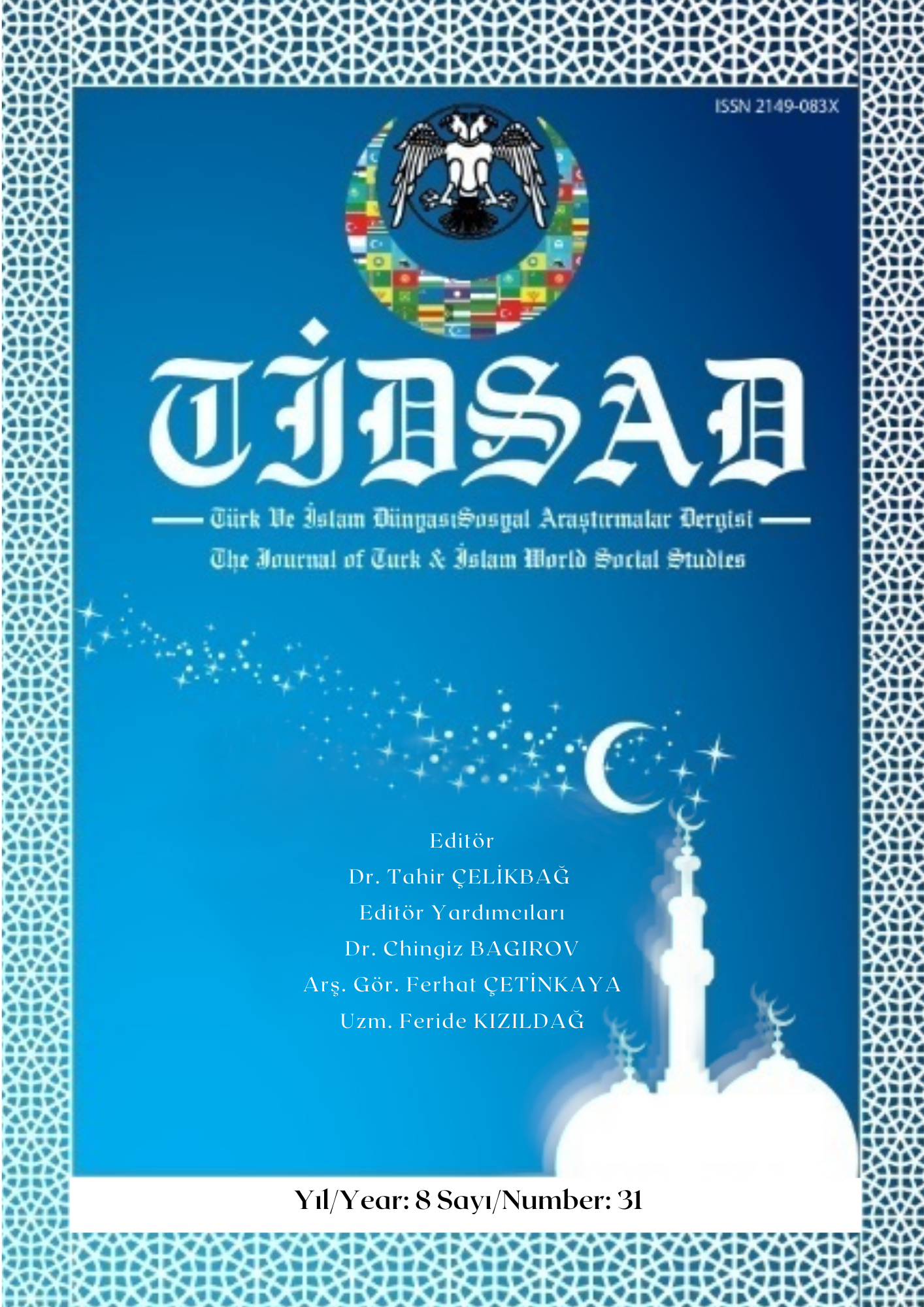Author :
Abstract
Geçmişten günümüze kadar heykel farklı amaçlar ile tasarlanıp üretilerek, çeşitli mekânlarda, galerilerde, kent meydanlarında, açık alanlarda görülmüş, gösterilmiş, sergilenmiştir. Cisimsel, hacimsel ya da kütlesel olarak heykel, kurumsal olduğu kadar sanatsal anlamda da konumlandığı yeri dönüştürmeye ve yaşam ile ilişkilendirmeye devam etmektedir. Bu makalede heykel sanatının bir kamusal alan olarak kent ile çevre arasında ilişkisine odaklanılacaktır. Bir kamusal alan olan kentin, heykeller ile değişen çehresinin kent insanının da değişim ve gelişimine ne gibi katkıları olabileceği de sorgulanacaktır. Bu bağlamda, Erzurum ili özelinde 2005-2010 tarihleri arasında düzenlenen taş heykel sempozyumlarıyla kentin dokusuna, plastiğine, sembolüne dönüşen taş heykellerin kente ve sanata dair katkıları üzerinden sanatçı okumaları yapılmıştır.
Keywords
Abstract
From the past to the present, the sculpture has been designed and produced for different purposes, and it still preserves its place today, as in the past, in various places, galleries, city squares, open spaces. Bodily, voluminous or massive, sculpture continues to transform the place where it is located in an artistic as well as institutional sense and to associate it with life. It will also be questioned how the changing face of the city, which is a public space, can contribute to the change and development of the people of the city.In this context, when the article is evaluated in terms of the stone sculpture symposiums held in Erzurum between 2005 and 2010, artist readings were made on the contributions of the stone sculptures, which turned into the skin, plastic and symbol of the city, to the city and to art.
Keywords
- Acar, B. (2016). Ekphrasis Görünür ve Söylenir Arasında Geçitler. (Birinci Basım). Corpus: İstanbul.
- Ak, B. (2012). Kamusal Alan ve Sanat. Mimarlık Dergisi. 364 Mart- Nisan 2012. Url: http://www.mimarlikdergisi.com/index.cfm?sayfa=mimarlik&DergiSayi=378&RecI D=2902.
- Çevik, N. ve Kayahan, Z. (2020). Bir Hafıza Mekânı Olarak Çağdaş Sanatta Kent Olgu- su/Teması Üzerine Bireysel Söylemler. Journal Of Social, Humanities and Administrative Sciences, 6(31), 1499-1509
- Çevik, N. ve Bingöl, M. (2021). Kamusal Alan Bağlamında Çağdaş Sanat Söylemleri. İnönü Üniversitesi Kültür ve Sanat Dergisi, 7 (1), 147-161.
- Çevik, N., Bingöl, M., Demirci Şenkal, A. (2021). Bir Tasarım Nesnesi Olarak Kamusal Alan- da Kaligrafik/Tipografik Düzenlemeler. Social Sciences Research Journal, 10 (3), 678695.
- Erman, O., Boran, B., (2015). Kentsel Mekânda Heykel Yerleştirmelerinin Değerlendirilme- si: Semiyotik Bir Model Önerisi. Çukurova Üniversitesi Eğitim Fakültesi Dergisi. 44(2),170-190.
- Gezer, H. (1984). Cumhuriyet Dönemi Türk Heykeli. Türkiye İş Bankası Kültür Yayınları. (Üçüncü Basım). Ankara: Tisa Matbaası
- Gökçen, Ş. (2018). Kamusal Sanat ve Kültür Eksenli Kentsel Dönüşüm. International Jour- nal of Interdisciplinary and Intercultural Art, 3(6), 215-236
- Karacan, N. (2013). Tarihsel Süreç İçinde Heykel Formu. Sanat ve Tasarım Dergisi, 4(17), 32.
- Koyunoğlu, Ö. E, (2021). Modern Türk Heykel Sanatının Doğuşu. Hece Aylık Edebiyat Dergi- si, 42(1), 639-674.
- Krauss, R. (2002). Mekâna Yayılan Heykel. Sanat Dünyamız (Çev.: Tuncay Birkan). Yapı Kredi Yayınları, sayı: 82, İstanbul.
- Kurtaslan, Ö. B. (2005). Açık Alanlarda Heykel Çevre İlişkisi ve Tasarım. Erciyes Üniversite- si Sosyal Bilimler Enstitüsü Dergisi, 1(18), 193-222.
- Lefebre H. (2016). Mekânın Üretimi (Çev.: Işık Ergüden) (4. Baskı). İstanbul: Sel Yayıncılık.
- Özkul, D. T. ( 2021). Kamusal Alan Bağlamında Bir Kent Müzesi Örneği: Ata Buz Müzesi. Hece Aylık Edebiyat Dergisi. Sanat Özel Sayı 42. Cilt 1.484-492.
- Parlakkalay, H. (2020). Kamusal Alanda Sanat ve Sanat Eserleri. Afyon Kocatepe Üniversite- si Sosyal Bilimler Dergisi, 22(4), 1157-1172.
- Perec, G. (2017). Mekân Feşmekan (Birinci Baskı). İstanbul: Everest Yayınları.
- Sağlam, F.(2011). Türkiye’de Gelenekselleşmiş Uygulamalı Heykel Sempozyumları. Çuku- rova Üniversitesi Sosyal Bilimler Enstitüsü Resim-İş Eğitimi Anabilim Dalı. Yayımlanmamış Yüksek Lisans Tezi.
- Şenyapılı, Ö. (2003). Otuz Bin Yıl Öncesinden Günümüze Heykel. Odtü Geliştirme Vakfı Ya- yıncılık ve İletişim A.Ş Yayınları.
- Yaman, Z. Y. (2011). Siyasi/Estetik Gösterge Olarak Kamusal Alanda Anıt ve Heykel. Orta Doğu Teknik Üniversitesi Mimarlık Fakültesi Dergisi, 28, 69-98.
- Yüksel, M. (2012). 1980’lerden Sonra Türk Heykel Sanatının Diğer Sanat Hareketleri İçin- deki Yeri. Çukurova Üniversitesi. Sosyal Bilimler Enstitüsü Dergisi, 21(2), 91-102.
- URL 1: https://bit.ly/3x6Xb5x. Erişim Tarihi: 28.06.2021
- URL 2: https://bit.ly/3cBDdq5. Erişim Tarihi: 28.06.2021
- URL 3: https://bit.ly/3qWlNg1. Erişim Tarihi: 29.06.2021
- Görsel 3. Füsun Onur, Herha ngi Bir İskemle, 1991. https://bit.ly/3gZxUDH
- Görsel 4. Luciano Fabro, Yerleşik Heykel, 1994. https://bit.ly/3gXieB4
- Görsel 5. Serap Bulat, Kapı, 2005. https://bit.ly/3nzSe1V
- Görsel 6. Mustafa Bulat, Çeşme, 2010. https://bit.ly/3nBvnTC.
- Görsel 7. Rahmi Atalay, Boğa, 2005 . İlhan Kaya’nın kişisel arşivinden.
- Görsel 8. Görüş Babayev, Palyaço, 2005. İlhan Kaya’nın kişisel arşivinden.
- Görsel 9. İlhan Kaya &Gökhan Taş, Curling, 2010. İlhan Kaya’nın kişisel arşivinden.
- Görsel 10.Ivane Tsiskadze, Boğa, 2010. İlhan Kaya’nın kişisel arşivinden.
- Görsel 11. Barış Aydın &Volkan Doğan, Çeşme, 2010. İlhan Kaya’nın kişisel arşivinden.





